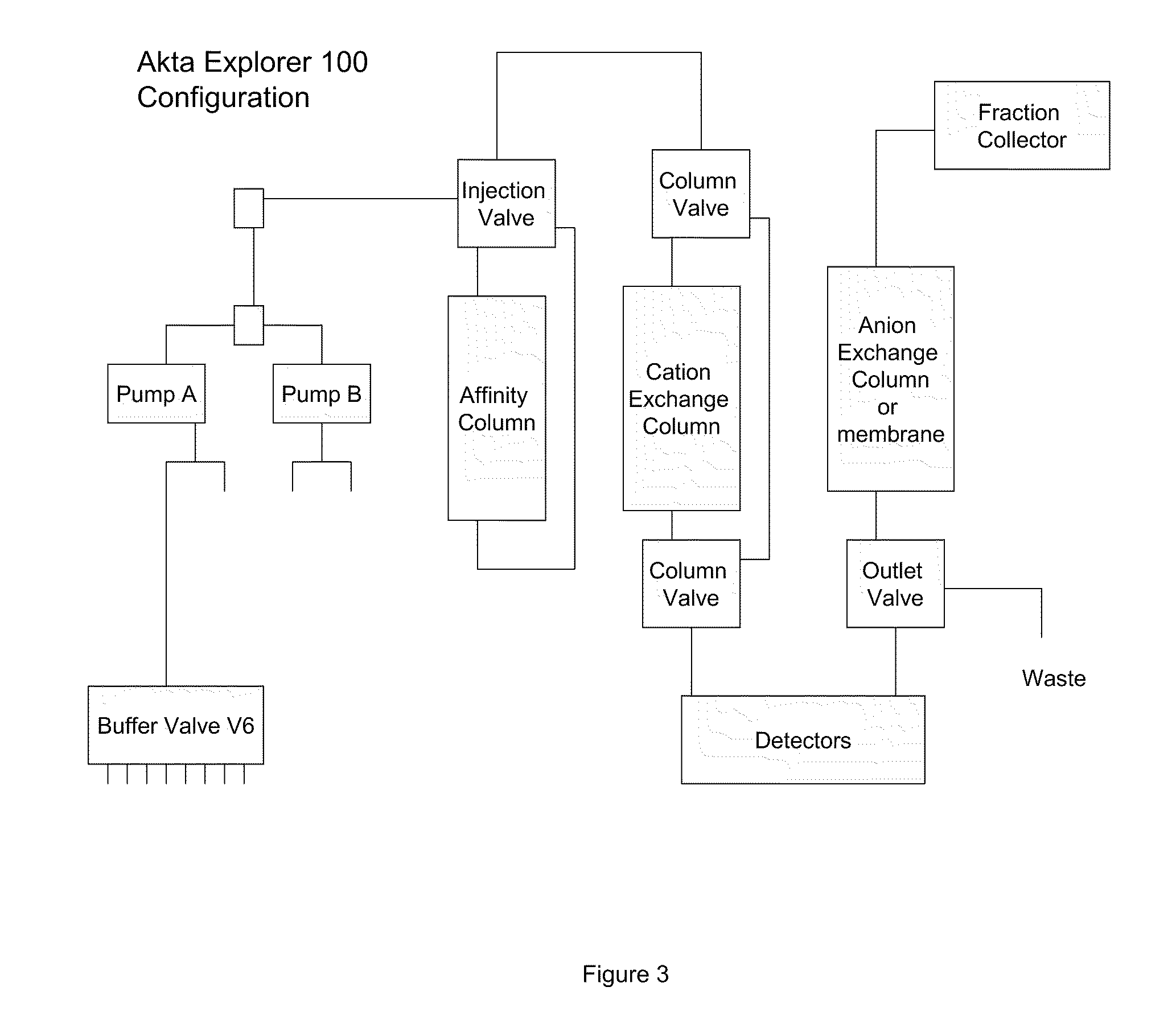Methods For Purifying A Target Protein From One or More Impurities In A Sample
a technology of target protein and impurity, which is applied in the field of protein purification, can solve the problems of difficult separation of desired protein from media components fed to cells, by-products of cells themselves, and other impurities that may exist, and achieve the effect of reducing the number of impurities in the sampl
- Summary
- Abstract
- Description
- Claims
- Application Information
AI Technical Summary
Benefits of technology
Problems solved by technology
Method used
Image
Examples
example 1
Comparison of Binding Capacities of Resins for Low pH Loading
[0115]Three cation exchange media were compared for dynamic capacity under the conditions listed in Table 1 (typical elution conditions for Protein A affinity chromatography) using the following method.
[0116]Exemplary cation exchange media having the following characteristics were used: porous, mono-disperse polymethacrylate resin with a mean particle size of 60 μm, pore size between 60-80 nm, a “S” ligand density between 170-270 μmol / mL of resin and having pressure-flow properties such that a 20 cm bed height can reach >400 cm / hr at 2 bar and the IgG capacity is >50 g / L at 3 minute residence time, commercially ProRes-S™ from Millipore Corporation, Fractogel-S® from EMD Merck and SP-Sepharose Fast Flow® from GE Healthcare were packed into omnifit columns (0.66 cm diameter, 7 cm bed height) (Bio Chem Valve, Inc., Boontown, N.J.) and tested for dynamic binding capacity of polyclonal human gamma globulin (IgG). The columns we...
example 2
Demonstration of Ion Exchange Steps Using a Model Feed under Direct Loading Conditions
[0117]In a representative experiment, a model protein feed was used for demonstration of recovery and purification of protein following direct loading of a cation exchange column followed by an anion exchange step.
[0118]A model Protein A elution pool was designed using the following mixture: 50 mM sodium acetate buffer pH 3.5, 2.5 g / L polyclonal IgG, n-Protein A 50-100 ppm and 10% wt HCCF from a non-expressing CHO cell line. A 7 cm×0.66 cm omnifit column packed with ProRes-S™ was equilibrated with 50 mM acetate buffer at pH 3.5 (5 column volumes, CV). The model Protein A elution pool mixture (˜20 mL) was loaded onto the ProRes-S™ column at 0.33 CV / min. After loading the protein mixture, the resin was then equilibrated with 3 CV of 100 mM citrate buffer at pH 5. Following equilibration at pH 5, the column was subsequently eluted with a series of pH steps starting with 50 mM Tris, pH 8.0 with 0.3M Na...
example 3
A Batch Mode Process for Purifying an Fc Region Containing Protein
[0119]In a representative experiment, a batch mode process for purifying a monoclonal antibody, which is an exemplary Fc region containing protein, was designed, where the process uses a Protein A resin, a cation exchange resin with loading at different pH conditions and an anion exchange. The process is described as follows. This experiment demonstrated conditions that would allow for direct loading of ion exchange steps following affinity capture without the need for a holding tank or a buffer exchange step.
[0120]An IgG expressing line of Chinese Hamster Ovary (CHO) cells was incubated in a stirred bioreactor for approximately 10 days. The cells were removed using a primary depth filter (Millipore DOHC) followed by secondary clarification with a second depth filter (Millipore XOHC). The IgG1 was purified from the harvested clarified cell culture fluid (HCCF) the using the following procedure:
[0121]The affinity step ...
PUM
| Property | Measurement | Unit |
|---|---|---|
| pH | aaaaa | aaaaa |
| pH | aaaaa | aaaaa |
| pH | aaaaa | aaaaa |
Abstract
Description
Claims
Application Information
 Login to View More
Login to View More - R&D
- Intellectual Property
- Life Sciences
- Materials
- Tech Scout
- Unparalleled Data Quality
- Higher Quality Content
- 60% Fewer Hallucinations
Browse by: Latest US Patents, China's latest patents, Technical Efficacy Thesaurus, Application Domain, Technology Topic, Popular Technical Reports.
© 2025 PatSnap. All rights reserved.Legal|Privacy policy|Modern Slavery Act Transparency Statement|Sitemap|About US| Contact US: help@patsnap.com



